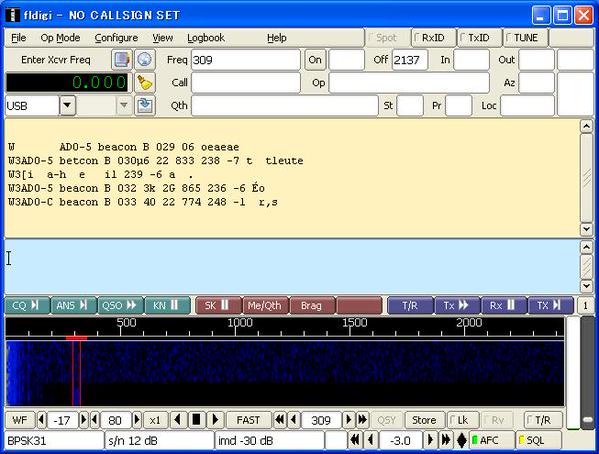Receiving the PSAT (and BRICsat) 435.350 MHz FM PSK31 downlink is as simple as placing the microphone of your laptop [or iPhone] running Fldigi or other PK31 software next to the speaker on your FM UHF receiver and just watching the waterfall.
What you see is exactly what everyone else sees (it’s FM). There is no Doppler added to the tones due to your station’s position relative to the satellite. But you DO have to retune your FM radio at least 3 times during the pass (+5 kHz, 0, -5 kHz) to stay in the FM passband. [Note: Users in the British Isles and Europe should remember to selected the wide FM (5 kHz deviation) filter setting on their rigs]
User uplinks, however, will shift in the waterfall according to each user’s position relative to the satellite. The shift can be as low as 1 Hz per second to as high as 6 Hz per second. This is because the uplink is on 10 meters where the Doppler rate is only 1/15th of what it would be on UHF.
The TELEMETRY channel at 315 Hz (PSAT) or 375 Hz (BRICsat) is FIXED with no Doppler since it is generated onboard into the FM downlink
What to do:
1) We need PSK31 authors to open the PSK31 frequency tracking to accommodate more than 1 Hz per second Doppler tracking. Current implementations can do 1 Hz/s but completely fail at 3 Hz/s. 2 Hz/s might work a little…
2) Until then, ANY uplink user that is in line with a direct overhead pass will have minimum Doppler at the start and end of there pass (1 Hz/sec) when the satellite is going right them and directly away from them. (Though it will be MAX (6 Hz/sec) when it passes over their station).
3) Just turn on MULTI CHANNEL window and let the PSK31 decode everyone. The ones with the least Doppler at any instant may be decoded for a while!
You can transmit PSK31 SSB in the 28.120-28.123 MHz segment and and receive the audio from an FM UHF rig on 435.350 +/- 5 kHz steps of Doppler. [Select wide FM filter]
DOWNLINK Limitations: The UHF downlink signal is only 300 mW and so a UHF beam is needed on the downlink.
UPLINK RESTRICTIONS: *NOTHING MORE THAN* a Vertical 1/4 wave or Dipole is authorized on the 10m uplink and no more than 25 Watts.
Remember a 1/4 wave vertical is the ideal antenna because it maximizes the signal at lower angles and tapers the signal as the satellite gets closer. This keeps user uplinks about the same during a pass. Strong stations just drive down the AGC and ruin it for everyone.
Use minimum power!! Remember, this is crossband FULL DUPLEX so you can see yourself in the downlink just like everyone else can see you. Act accordingly. And of course DO NOT TRANSMIT if you cannot see the waterfall.
Enjoy!
Bob, WB4APR
ParkinsonSAT (PSAT) http://www.aprs.org/psat.html
Fldigi PSK31 software http://www.w1hkj.com/Fldigi.html
Listen to satellite signals in the 145 and 435-438 MHz bands from anywhere in the world using the online SUWS WebSDR located near London. Further details at http://amsat-uk.org/2014/08/15/suws-websdr-moves-to-new-site/

